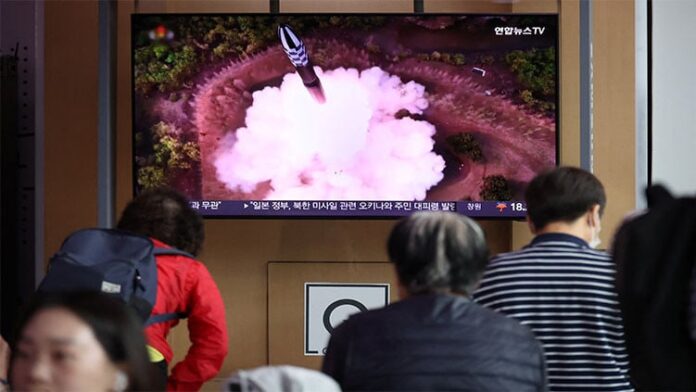SEOUL: A North Korean satellite launch on Wednesday ended in failure, sending the booster and payload plunging into the sea, North Korean state media said, and the South’s military said it had recovered parts of the launch vehicle.
The new “Chollima-1″ satellite launch rocket failed because of instability in the engine and fuel system, state news agency KCNA reported.
The flight was the nuclear-armed state’s sixth satellite launch attempt, and the first since 2016. It was supposed to put North Korea’s first spy satellite in orbit.
It prompted emergency alerts and brief evacuation warnings in parts of South Korea and Japan. The notices were withdrawn with no danger or damage reported.
South Korea’s Joint Chiefs of Staff said on Wednesday the military was conducting a salvage operation to recover what is believed to be parts of the space launch vehicle. The military shared pictures of debris pulled from the water.
Officials from the United States, Japan, South Korea held a phone call, where they “strongly condemned” the launch, Japan’s foreign ministry said.
“The three countries will stay vigilant with high sense of urgency”, the statement said.
North Korea had said it would launch its first military reconnaissance satellite between May 31 and June 11 to boost monitoring of U.S. military activities.
South Korea last week placed satellites in orbit with a domestically designed and produced rocket for the first time, and China sent three astronauts to its space station as part of crew rotation on Tuesday.
The rocket plunged into the sea “after losing thrust due to the abnormal starting of the second-stage engine,” KCNA reported, in an unusually candid admission of a technical failure by the North.
Pyongyang’s National Aerospace Development Administration (NADA) will investigate the “serious defects” and take action to overcome them before conducting a second launch as soon as possible, KCNA said.
Warnings issued
In data provided to international authorities, North Korea said the launch would carry the rocket south, with stages and other debris expected to fall over the Yellow Sea and into the Pacific Ocean.
Air raid sirens wailed across the South Korean capital of Seoul about 6:32 a.m. (2132 GMT Tuesday) as the city warned citizens to prepare for a potential evacuation. Later alerts said the city warning had been a mistake.
“I was so panicked. Nine-one-one lines were busy and the internet was slow,” said Lee Juyeon, 33, a resident in the city of 9 million who was preparing to shelter in a basement with her young child before learning it was a false alarm.
Calm quickly returned in Seoul, while South Korean stocks and the won currency traded firmer.
The Japanese government also issued an emergency warning over its J-Alert broadcasting system for residents of the southern prefecture of Okinawa to take cover indoors early on Wednesday morning.
It later said the rocket would not fly into Japanese territory and lifted the warnings.
Missile technology
On Tuesday, Ri Pyong Chol, vice-chairman of the Central Military Commission of North Korea’s ruling Workers’ Party, said ongoing joint military exercises by the U.S. and South Korea required Pyongyang to have the “means capable of gathering information about the military acts of the enemy in real time.”
The White House condemned a launch using ballistic missile technology and said in a statement it was assessing the situation in coordination with allies.
Japan’s Chief Cabinet Secretary Hirokazu Matsuno said North Korea’s rocket disappeared from radar above the Yellow Sea and did not make it into space, and added the government had no further information to share now.
“We strongly condemn North Korea’s actions,” he said. Tokyo lodged a complaint to Pyongyang through diplomatic channels in Beijing, he said.
Before Wednesday’s launch, the U.S. State Department said any North Korean launch that used ballistic missile technology would violate multiple United Nations Security Council resolutions.
“Space launch vehicles (SLVs) incorporate technologies that are identical to, and interchangeable with, those used in ballistic missiles, including intercontinental ballistic missiles,” a State Department spokesperson said.
North Korea has attempted five other satellite launches, with two placed in orbit, including during its last such launch in 2016. Its capacity for constructing working satellites remains unproven, however, analysts say.
“To the best of our knowledge, North Korea has a very limited capacity to build satellites,” said Brian Weeden of the Secure World Foundation, a U.S.-based space policy and security organisation. “They have launched a couple of satellites before, but all of them failed immediately after launch or shortly thereafter and none of them appeared to have any significant capability.”






















